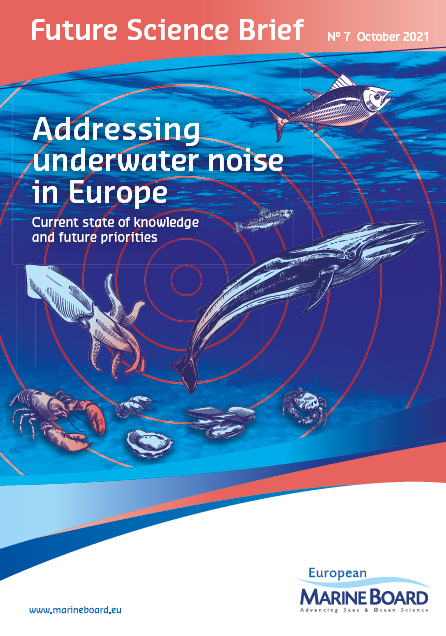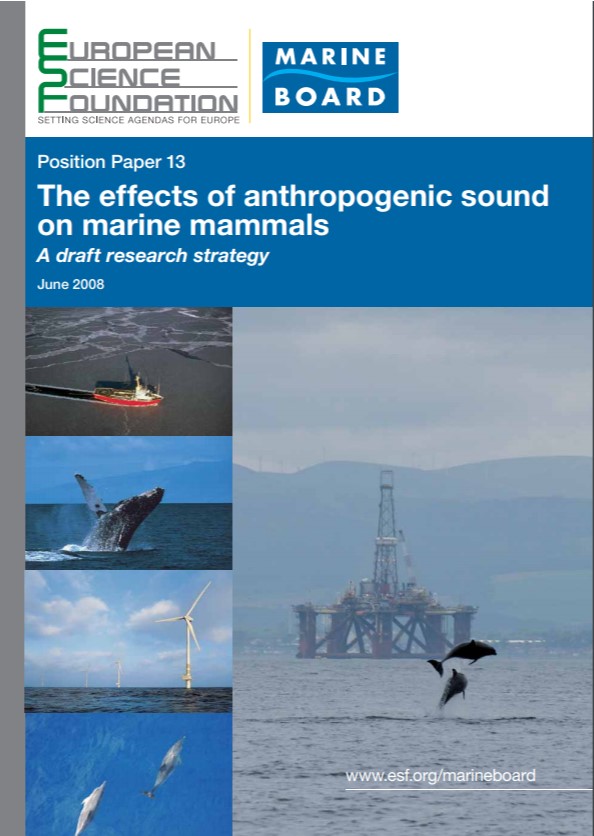Output
 Future Science Brief 17, Addressing underwater noise in Europe: Current state of knowledge and future priorities (October 2021)
Future Science Brief 17, Addressing underwater noise in Europe: Current state of knowledge and future priorities (October 2021)
 Position Paper 13, The effects of anthropogenic sound on marine mammals: A draft research strategy (June 2008)
Position Paper 13, The effects of anthropogenic sound on marine mammals: A draft research strategy (June 2008)
Article on What's next for underwater noise research and management in Europe: Priority actions in ECO Magazine (September 2022)
EMB Science Webinar on Addressing underwater noise in Europe (November 2021)
Background
Sounds underwater arise from a very wide variety of sources, both natural and human-made (anthropogenic). Natural sounds include those generated by a wide range of marine fauna, waves, rain, wind, and seabed movement, while anthropogenic sounds from human activity at sea include shipping and other marine craft, building and installations, sonar and seismic surveys.
As light does not travel far within the ocean, most marine fauna rely on sound, sound pressure and/or vibration to perceive the world around them. The presence of anthropogenic sound therefore has the potential to interfere with and impact on marine fauna.
The European Marine Board Position Paper 13 “The effects of anthropogenic sound on marine mammals: A draft research strategy” of June 2008 recommended the use of a four-step analytical risk framework process adapted to the issue of marine mammals and anthropogenic sound to assess and identify priority research topics for reducing uncertainty. More than ten years on, the research landscape has evolved and a significant body of work has been published in developing our understanding of the impacts of underwater noise on a wider range of marine species including fish and invertebrates.
At a European policy level, the EU’s Marine Strategy Framework Directive (MSFD) was adopted in June 2008 and recognized underwater noise as an ocean pollutant for the first time, with Descriptor 11 for Good Environmental Status (GES) specifically referring to underwater noise. Globally, development in the monitoring of ocean sound has been the approval by the Global Ocean Observing System (GOOS) of an ocean sound Essential Ocean Variable (EOV), initiated by the Partnership for Observation of the Global Ocean (POGO) and the International Quiet Ocean Experiment (IQOE), and which will be overseen by IQOE.
This working group provides input to the UN Decade of Ocean Science for Sustainable Development (2021-2030) societal outcome that aims for a clean ocean.
Objectives
The EMB activity on underwater noise will seek to provide an update on progress related to this topic since the 2008 EMB publication, to raise awareness of the current knowledge and research gaps, to broaden the scope from marine mammals to all marine organisms, and to highlight the inherent conflicts that exist relative to underwater noise and its use.
Specifically, the objectives of this group could include but will not be limited to:
- Highlighting current understanding and existing research on the impact of different underwater noise sources on marine fauna, and the ultimate chronic and cumulative short- and long-term ecosystem impacts;
- Consider relevant updates to existing regulation e.g. to consider impacts as well as noise levels, and to consider soundscapes rather than individual noise sources;
- Explore research and policy gaps in understanding underwater noise baselines e.g. for MSFD;
- Highlight the difficulties and aspects to consider when establishing appropriate underwater noise mitigation measures;
- Identify areas in which conflict related to underwater noise can arise and trade-offs have to be considered, e.g. marine seismic research and offshore renewable energy;
- Consider current barriers to progress, including collaboration needs (between marine sciences, maritime fields and policy) and research funding limitations;
- Investigate research needs linked to the setting of international standards for measurement and experiments;
- Providing appropriate scientific input to developments linked to the ocean sound EOV; and
- Where appropriate, proposing updates to the recommendations presented in EMB PP 13.
Terms of Reference
The Terms of Reference produced for the operation and objectives of this Working Group can be consulted here (November 2019).
Meetings
- 8 June 2020, Online
- 30 June 2020, Online
- 1 September 2020, Online
- 19 November 2020, Online
- 12 January 2021, Online
- 11 March 2021, Online
- 19 May 2021, Online
- 7 June 2021, Online
Members
Chair: Frank Thomsen, DHI, Denmark
Co-Chair: Sonia Mendes, JNCC, UK
Working group members:
Alessandro Cresci, IMR, Norway and EMB Young Ambassador
Carina Juretzek, BSH, Germany
Cecile Ducatel, Ifremer, France
Elena Ciappi, CNR, Italy
Elisabeth Debusschere, VLIZ, Belgium
Frans-Peter Lam, TNO, Netherlands
Frederic Bertucci, Laboratoire BOREA, France
Joanne O’Brien, GMIT, Ireland
Manuel dos Santos, ISPA, Portugal
Monika Breitzke, Germany
Thomas Folegot, Quiet-Ocean, France
EMB Communication Panel support: Kathrin Kopke - UCC, Ireland
Contact at European Marine Board Secretariat: Paula Kellett Email